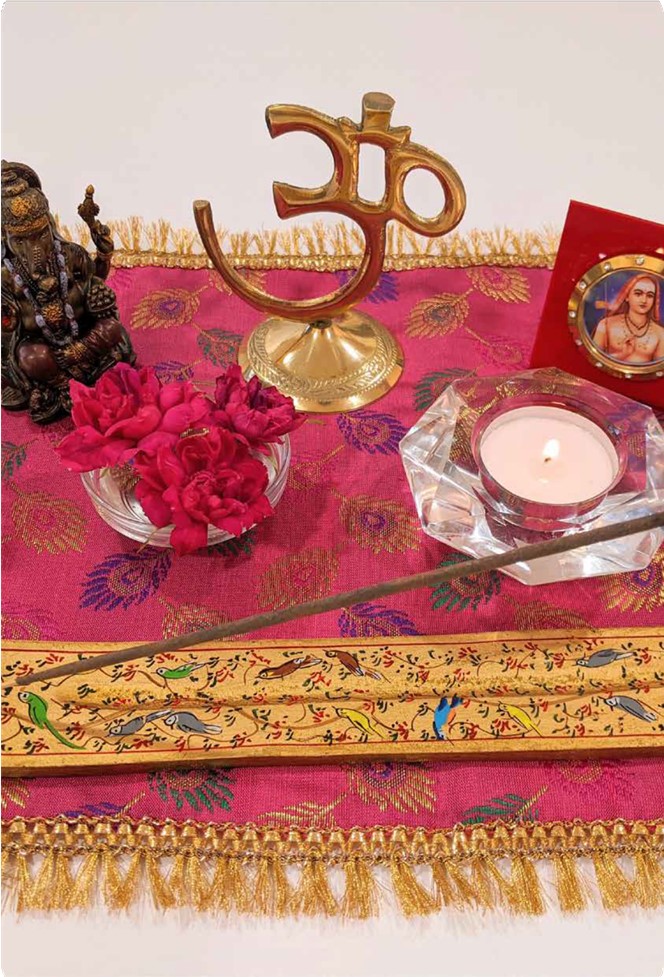 CREATE YOUR OWN SPIRITUAL POWER CENTRE AT HOME
CREATE YOUR OWN SPIRITUAL POWER CENTRE AT HOME
BY SWAMI BHAGAVATANANDA
“The supreme state is Self-realisation or Brahma- sakshatkara. The second in rank is meditation. The Yogi practises Sadhana or unceasing meditation on the Supreme Self. The third is the worship of symbols. The fourth is the performance of rituals and pilgrimages to holy places.”
– Swami Sivananda
Spiritual seekers have always taken inspiration and strength from places that are naturally charged with pure and uplifting energies. Many of these places we find in nature, like the bank of a river, by the sea, deep in a forest or high on a mountain top. Prana (vital energy) and Sattva (purity) are naturally abundant in these places.
Then, some of these high-prana-places are man-made and serve as pilgrimage centres, like temples, churches, synagogues, mosques or ashrams. The Sadhana (spiritual practices) and prayers done in these places, accompanied by Mantras or any kind of spiritual chants and the pure thoughts left behind by saints and yogis who have been spending time at these places also create a powerful atmosphere conducive to spiritual growth.
Many pilgrimage centres actually combine both the power of nature and the power of prayer, like the many temples to be found at the banks of the Ganga or up in the Himalayas. Or for example all those ashrams that have been established in a peaceful nature setting, away from the hustle and bustle of city life.
By visiting these places, we tune into these pure and powerful energies and absorb them for our benefit. It is true, that an advanced yogi can meditate anywhere, even in a busy public place in downtown London or any other metropole, but, honestly, who is truly that advanced, except a few saintly beings? The rest of us, we need all the support we can get to uplift and control our mind. As we know from psychology, our environment influences our mental state; we constantly absorb on a subconscious level the energies and thoughts of people and situations around us, positive and negative.
The mind works by force of association, whatever surrounds us, is absorbed into the mind. Sometimes we even need protection from our own mind, when it decides to bring up negative thoughts all on its own. Hence, the necessity to surround ourselves with positive energies or what the yogic scriptures call “good company” to help us to create and maintain a peaceful, clear state of mind.
So, what are we waiting for, let’s go on a pilgrimage to the sacred spots in the Himalayas right now! Ahem, small problem? Closed borders? Transportation limited?
Access to nature spots restricted? Financial limitations?
Well, we’ll simply need to create our own spiritual power centre at home, which is a lovely thing to do, because we’ll have access to it all the time, 24/7. Also, the lockdown taught us the value of spending time at home, so what could be a better home improvement plan than transforming your living space into a little ashram?
It is much easier than one might think and can be achieved through 3 means:

1. Create a sattvic (pure, harmonious) environment
In Yoga, this is called Saucha, purity.
Purity is of two kinds, internal purity and external purity. Freedom from Raga-dvesha (likes and dislikes), purity of intentions, purity of motives, and purity of Bhava (feelings) constitute internal purity. Purity of body through bath, etc., purity of clothes, purity of surroundings like the house and its neighbourhood, constitute external purity. External purity generates pure thoughts.
– Swami Sivananda
When we are in an unclean and disorganised place, it is difficult to keep a clear, structured mind. Therefore, keep your home clean – especially your Sadhana place, but it applies to the whole place, as energies radiate out.
Maintaining Sattva in your home is not only about removing clutter and dust, but also to uplift and increase the Prana level of your place and allow a free flow of Prana.
If the meditation place is clean, but the kitchen isn’t, this uncleanliness will spread out.
Leave the shoes by the door. They carry the energy of the hectic world around you. It is better to avoid bringing this kind of energy into your home.
For the same reason, take a shower and change your clothes when you get home from work, because your clothes and your skin also absorb the energy of your surroundings. Water energizes us and neutralizes negative energies.
Keep a set of clothes made of natural fibres like cotton exclusively for your spiritual practice and wash them frequently. If you wear your office attire for meditation, it will remind you of your office work and cause distraction.
While cleaning, don’t forget to check on hidden dust-traps in your home, like under the bed and on book shelves and avoid dusty curtains.
The fridge can be another hotspot. We tend to think, the fridge is automatically a sterile zone – unfortunately it is not. Hence, wipe out your fridge weekly. Best is, to cook only as much food as you can eat, which also saves you from the dilemma of throwing away leftovers and wasting food.
Air out your place well, especially if your yoga practice happens in the same room where you sleep. Fresh air is full of Prana.
Keep your home not only clean, but also tidy – an untidy place makes an untidy mind and disturbs the Prana flow.
The great Yogi Ramakrishna Paramahamsa trained his disciples to always return everything to the spot from where they took it. He saw that as a spiritual practice and concentration exercise.
Feng Shui and Vastu teach us that even clutter in a non-visible place, like for example a closed cupboard, has a heavy, depressing effect on our physical and mental wellbeing. A good spring-cleaning (at any time of the year) where we give away unused stuff will take care of this.
 2. Establish a little sacred place
2. Establish a little sacred place
You do not need to be a religious person to benefit from an altar. An altar is the spiritual heart of your place. On your altar, you put symbols that radiate Prana and positivity.
Your altar will remind you of your Higher Self and serve as focal point for your meditation. If you are of an devotional temperament, your altar becomes a powerful channel to communicate with the Divine.
A symbol is absolutely indispensable for fixing the mind. The mind wants a prop to lean upon. It cannot have a conception of the Absolute in the initial stages. Without the help of some external aid, in the initial stages, the mind cannot be centralised. In the beginning, concentration or meditation is not possible as your personal power centre.
According to the yogic scriptures, it is best to have a separate room for your Sadhana, as it keeps that room free from worldly influence and a powerful spiritual energy can grow.
But if we’re sharing our home with several people or are living in a tiny studio, a reality check will suggest that this is not be possible.
What to do?
Dedicate a small area of your home to your spiritual practice and arrange a shelf or screen or a house-plant in such a way that it creates a protected area. Keep that little space extra-clean and neat and use it only for spiritual practices like asanas, pranayama, meditation, mantra repetition, chanting
and spiritual reading. Avoid bringing social media, internet, television, non-spiritual reading matter and overstimulating music into that place and don’t chitchat or take your meals there either.
Now comes a very important step: establish an altar!
You do not need to be a religious person to benefit from an altar. An altar is the spiritual heart of your place. On your altar, you put symbols that radiate Prana and positivity.
Your altar will remind you of your Higher Self and serve as focal point for your meditation. If you are of an devotional temperament, your altar becomes a powerful channel to communicate with the Divine.A symbol is absolutely indispensable for fixing the mind. The mind wants a prop to lean upon. It cannot have a conception of the Absolute in the initial stages. Without the help of some external aid, in the initial stages, the mind cannot be centralised. In the beginning, concentration or
meditation is not possible without a symbol.
– Swami Sivananda
From your altar, positive energy will radiate out into the rest of your home.
An altar will inspire you and remind you not to forget your spiritual practice.
And when you feel exhausted, depressed or hurt by the ways of the world, just sitting in front of your altar will comfort you and fill you with new strength and positivity.
What goes on the altar?
• Choose North or East for your altar, as these directions are conducive to your spiritual practice.
• Set up a low table or a low shelf for your altar, so that you can sit crossed-legged in front of it without straining your neck.
• Cover it with a beautiful cloth, because if we see something beautiful, the mind gets uplifted.
• In case, you set up your altar on the floor, put it on a tray or a piece of cloth, so that your altar items don’t touch the floor directly (this would dissipate the energy).
• If you are sharing your home with people who resent having an altar around all the time, set it up in a cupboard with doors or a curtain and close it once you’ve finished your Sadhana.
A candle or an oil lamp.
• Light is an expression of positivity, beauty and warmth, Light also represents clarity and knowledge and symbolizes the Light of our Soul.
• Make sure you extinguish your candle before you leave the place.
A flower
• You can use a flower in a vase or a potted flower or flower heads or petals or a flower garland. Just don’t put a prickly cactus!
• Flowers uplift our mood by their beauty. They also radiate a sweet, gentle energy, softening our heart when we look at them. They represent the blossoming of our Sadhana.
A spiritual symbol
• Choose whatever inspires you, whatever uplifts your mind. It can be a stone
or a conch that you collected during a vacation by the sea or a statue or a
picture of Krishna, Jesus, Buddha, Vishnu, Siva, Durga, Ganesha, Lakshmi, Sarasvati, OM …
• One symbol only is enough, but you can also put several. But the one with the most important meaning to you should be in the middle.
• If you have been initiated into an Ishta- Mantra (mantra dedicated to one specific form of the Divine), you should put that symbol in the centre.
• If you have a spiritual Master, put a picture of him/her on the altar.
• It will invoke the blessing and protection of your Master.
• Optional: an incense of good, natural quality in an incense holder or an essential oil cold diffuser; use only pure, high quality essential oils.
• Don’t use incense made of chemical fragrances, they are bad for your health and bad for the Prana in your room!
• The smoke from an incense has purifying qualities.
• A calming, pure fragrance, for example sandalwood, will set the proper atmosphere for meditation.
• Burning incense symbolizes burning the ego: when we work to overcome the ego, it will create smoke (some resistance and emotional pain) , but when it’s finally gone, only sweet fragrance will remain in the form of a positive, loving mind.
3. Perform Arati daily at your place
Arati is the yogic light ceremony to purify and uplift the vibratory level of any place. It combines the purity and positivity of light with the purity and positivity of Mantras.
Lights also represents our Supreme Self or the Divine. We remember our true Self during Arati.
Arati is especially helpful to counteract negative or disturbing energies – for example after renovations in your home, an awkward visit, a quarrel, etc.
But in fact, Arati should be done daily under any circumstances, just for the sake of uplifting and purifying your mind and your home.
The Sivananda Centres and Ashrams do Arati twice daily, morning and evening.
All over India, Arati is done in temples as highlight of a spiritual ceremony. The principle of waving light is always the same, but the mantras can be very different according to which aspect is invoked, for example during the Ganga Arati which is performed along the banks of the Ganges, Mantras praising Ganga are chanted.
What you need for doing an Arati:
An Arati lamp or a tea candle on a little plate or an incense
• the function of an Arati lamp is that you can hold it in your hand and wave it around while it is lit, so, any set up that fulfils this purpose will do.
A little bell
• the sound of a bell drowns out worldly sounds and reminds us that time is precious and that we should use it to focus on the present moment and do Sadhana.
• Prasad as an offering (fresh fruits or sweets or dried fruits like raisins).
• What you use for Prasad should be used only for Prasad, don’t taste it before it is offered at the altar and don’t use leftover fruits (like half a banana). You can for example keep a little bag of raisins close to your altar and each time take out only your daily portion needed for Arati.
• The meaning of Prasad: literally “Grace”.
• It represents a selfless act – we offer, instead of taking, thus purifying the heart. Symbolically it also means offering the fruits of our actions to the Divine.
• Practical effect: Prasad is kept during Arati at the Altar and gets charged with the positive energy of light and the mantras of the Arati and then afterwards we eat this positivity by eating Prasad.
How to do Arati:
• Put the bowl with Prasad on the altar and put a little portion of it directly in front of your spiritual symbol
• light your Arati lamp/tea candle/incense
• take the Arati lamp in your right hand and touch your left hand to your right hand or forearm. Stand at the side of your altar.
• If a second person is present, he/she can ring the bell. If not, take the bell in your left hand.
• Chant the mantras of the Arati, calmly waving the light clockwise in big circles in front of the altar while ringing the bell
• At the end of the Arati, take the lamp in your left hand and with your right
palm symbolically wave the light 3 times towards the altar. Then put the Arati lamp down and put both your hands above the flame and pass them over your third eye and head to symbolically connect with the light.
• If other people are present, offer the light to the altar first, then take it back into your right hand and offer it to all present. Then you take it last. For extinguishing the flame, wave it out or use a candle extinguisher. Don’t blow it out. Fire is considered too pure to be touched with the breath.
• Prostrate. The symbolical meaning of a prostration is the surrendering of the
ego. By prostrating, we indicate that our Higher Self is given priority and the ego comes second place.
• Distribute Prasad among all present. The little portion you offered directly to your spiritual symbol should remain a while
at the altar, then you can dispose of it somewhere in nature like into a river or under a tree. Most Yoga masters even agree that you can eat it, once it has been at the altar for a while
Mantras to be chanted during Arati
Here a simple, but powerful version:
• 3 x OM
• 3 x Om Gam Ganapataya Namah (invocation of Ganesha, the energy to remove obstacles)
• 3 x Om Gum Gurubhyo Namah (Invocation of the spiritual teacher)
• 3 x Om Aim Sarasvatyai Namah (Invocation of Sarasvati, the energy of knowledge, wisdom and creativity)
• Then you can select the Mantra(s) of the deity/deities that you have on your altar and chant some or all of them, each three times :
• Om Namah Sivaya (Siva, energy of transformation)
• Om Namo Narayanaya (Vishnu, energy of peace)
• Om Sri Ramaya Namah (Rama, energy of Dharma = duty)
• Om Namo Bhagavate Vasudevaya (Krishna, energy of cosmic love)
• Om Dum Durgayai Namah (Durga, cosmic energy behind all everything)
• Om Hreem Mahalakshmyai Namah (Lakshmi, energy of positivity and abundance)
• If you have a spiritual Master, chant his/ her name as well, for example, if you feel connected to Swami Sivananda, chant three times: Om Namo Bhagavate Sivanandaya
Minimalistic Arati
• wave a lit incense clockwise and chant a few times “Om Om Om” before offering the light of the incense to the altar.
Full Arati
• The full Arati that is chanted during the Satsangs at the Sivananda Centres is quite long, since in the universal spirit of Yoga it invokes many forms and manifestations of the Divine.
• If you feel inspired to learn it, here is a link to the text with translation.
• https://sivanandaorleans.org/wp-content/ uploads/2020/05/Arati-engl-with- meaning.pdf
• Download it and chant along in the Satsangs to learn it bit by bit by heart!































